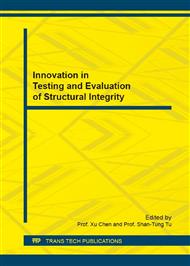[1]
Tada H, Paris PC, Irwin GR. Stress analysis of cracks handbook. 3rd ed. ASME; (2000).
Google Scholar
[2]
Murakami Y, Hasebe N, eds. Stress intensity factors handbook. Elsevier Science, (2001).
Google Scholar
[3]
Newman Jr JC, Raju IS. Stress-intensity factor equations for cracks in three-dimensional finite bodies subjected to tension and bending loads. Computational methods in the mechanics of fracture 1986; 2: 311-334.
DOI: 10.1520/stp37074s
Google Scholar
[4]
Mcclung RC, Lee YD, Liang W, et al. Automated fatigue crack growth analysis of components. Fatigue 2010; 2(1): 629-637.
DOI: 10.1016/j.proeng.2010.03.068
Google Scholar
[5]
Bueckner HF. A novel principle for the computation of stress intensity factors. ZAMM 1970; 50: 529-546.
Google Scholar
[6]
Rice J. Some remarks on elastic crack-tip stress field. International Journal of Solids and Structures 1972; 8: 751-758.
DOI: 10.1016/0020-7683(72)90040-6
Google Scholar
[7]
Moftakhar AA, Glinka G. Calculation of stress intensity factors by efficient integration of weight functions. Engineering Fracture Mechanics 1992; 43(5): 749-756.
DOI: 10.1016/0013-7944(92)90005-y
Google Scholar
[8]
Wu XR, Carlsson AJ. Weight functions and stress intensity factor solutions. Pergamon press (1991).
Google Scholar
[9]
Newman JC, Yamada Y, James MA. Stress-intensity-factor equations for compact specimen subjected to concentrated forces. Engineering Fracture Mechanics 2010; 77(6): 1025-1029.
DOI: 10.1016/j.engfracmech.2010.02.012
Google Scholar
[10]
Petroski HY, Achenbach FD. Computation of the weight function from a stress intensity factor. Engng Fracture Mech 1987; 10: 257-266.
DOI: 10.1016/0013-7944(78)90009-7
Google Scholar
[11]
Glinka G, Shen G. Universal features of weight functions for cracks in mode I. Engineering Fracture Mechanics 1991; 40(6): 1135-1146.
DOI: 10.1016/0013-7944(91)90177-3
Google Scholar
[12]
Kiciak A, Glinka G, Eman M. Weight functions for corner crack in finite thickness plate subjected to in-plane loading. Engineering Fracture Mechanics 1998; 60(2): 221-238.
DOI: 10.1016/s0013-7944(98)00006-x
Google Scholar
[13]
Glinka G. Development of weight functions and computer integration procedures for calculating stress intensity factors around cracks subjected to complex stress fields. Stress and Fatigue-Fracture Design, Petersburg Ontario, Canada, Progress Report, 1996 (1).
DOI: 10.1016/s1566-1369(99)80041-7
Google Scholar
[14]
Shen G, Glinka G. Weight functions for a surface semi-elliptical crack in a finite thickness plate. Theoretical and Applied Fracture Mechanics 1991; 15, 247-255.
DOI: 10.1016/0167-8442(91)90023-d
Google Scholar
[15]
Chen X, Albrecht P. Weight functions for eccentric cracks. ASTM Special Technical Publication 1994; 1207: 581-581.
Google Scholar
[16]
Isida M. Stress intensity factors for the tension of an eccentrically cracked strip. Journal of Applied Mechanics; 1966: 674-675.
DOI: 10.1115/1.3625138
Google Scholar
[17]
Southwest Research Institute. DARWIN® Theory. 6. 1 ed. (2008).
Google Scholar


